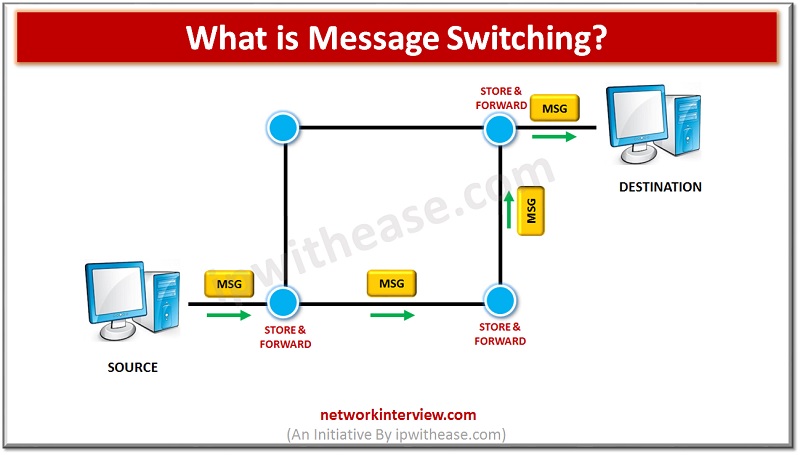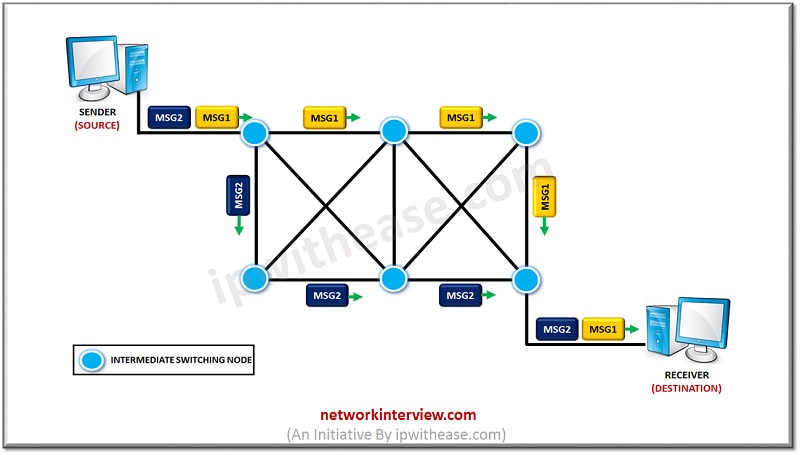
What is Message Switching?
Introduction to Network Switching
Before understanding Message Switching, let’s explore the basic types of switching.
Switching is an important mechanism that provides communication between different networks or different computer(s) and manages the data flow between the two end points. There are three types of switching techniques –
- Circuit switching
- Packet switching
- Message switching.
For Details – Network Switching & its Types
Here we will discuss Message Switching.
Message Switching
It is a switching method that was developed as an alternative to Circuit switching before the advent of Packet Switching. Message switching is a connectionless technique in which the entire message is routed from the source node to the destination node by one hop at a time, called hop-by-hop system. The distinctive features of message switching are:
Store and Forward network: The message is not discarded in case of non availability of the next hop. Rather, it is stored in a queue and is retransmitted when the required route is available .This is called store and forward network.
Message delivery: The entire information is wrapped in a single message and transferred from the source to the destination node as a “message” with a definite destination address in the header.
The Process of Message Switching
In Message switching, each message is regarded as an individual unit. Destination address is added to the message by the sender node and the message is delivered entirely to the next available intermediate switching node. The intermediate node stores the message and after doing the requisite checks like destination address, transmission errors etc. , delivers the message to the next available intermediate node. The process continues with the store and forward technique until the message reaches its destination.
Below diagram represents the delivery of two separate messages, MSG1 and MSG2 from the same source using different routes to reach the same destination ( Message Switching) −
Advantages
- As the communication channels are shared by the network devices, it ensures better bandwidth usage.
- It helps in reducing the network congestion due to store and forward method. Switching nodes can store the messages incase of unavailability of the communication channel, thus helping in reducing the traffic congestion.
- It can send messages of unlimited sizes.
- Out of order packets or lost packets does not affect Message Switching unlike Packet Switching.
- The transfer rate of the sender and the receiver need not to be the same as the message can be stored by the nodes.
Disadvantages
- Each intermediate switching node requires large storage capacity as the message is to stored at each intermediate node.
- This Store and forward method also causes delay, rendering it unsuitable for real time applications like video conferences.
FAQs Related to the Topic
- What is the difference between Message Switching and Packet Switching ?
- In message switching, a complete message is passed across the network, while in packet switching it is broken into units called packets.
- Which switching technique can be used in real time, Circuit Switching or message Switching
- Circuit Switching can be used in real–time as the communication channel is dedicated which ensures a steady rate of data transfer essential for real time applications. Message Switching is not suitable for real time applications as its store-and-forward technique causes delay.
- What is the difference between Message Switching and Circuit Switching?
- In Circuit Switching, a dedicated physical connection is established between two devices while in message switching is a connectionless switching techniques based on store and forward mechanism.
- Where is Message Switching used?
- Message switching is used for electronic mail and telex transmission. However, majority of message switching links have been replaced by packet/circuit switching.
- What are the key features of Message Switching?
- The key features of message switching are: store-and-forward mechanism and hop-by-hop system.
To explore more questions related to Network Switching, please read our e-book on Switching Interview Q&A



